Royal Netherlands Naval Air Service MLD
[ page 1 ]
Revell Breguet Atlantic model in 1/72 scale made by Meindert de Vreeze
last update Page 2...
Based on a NATO requirement, a maritime patrol aircraft was developed in Europe, and known at the Atlantic, the prototype flew in 1961. The type was bought by France, Germany, The Netherlands and also later by other countries like Pakistan. The type has a 'double-bubble' shape and the outboard wings some dihedral. Systems included a retractable CSF radar, MAD boom, and ECM pod on top of the vertical fin. Production was done by a consortium, eg. also Fokker Aircraft company in The Netherlands which built the wing mid sections.
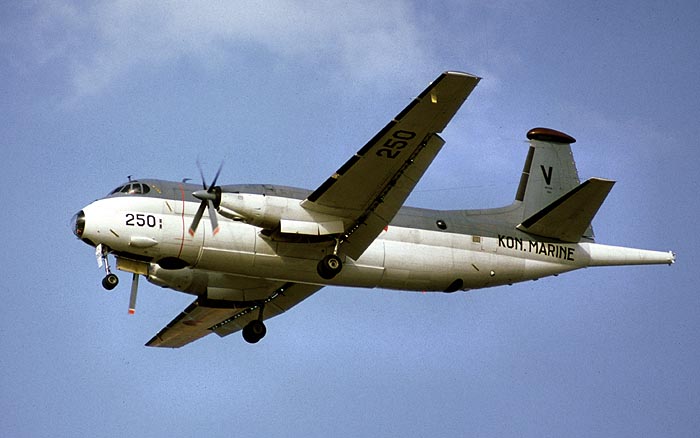
(photo: M. de Vreeze... yeah that's me)
Some technical
figures:
2 x Rolls Royce
Tynes 20-mk.21 with 6100 ehp. engines
Max. speed
: 658 km/h
Patrol speed
: 320 km/h
Max weight
: 43000 kg
Radius : 9000
km long range
Fuselage length
(incl.MAD) : 31,75 m
span : 36,30
m
height
: 11,33 m
propeller diameter
: 4,88 m (four blades)
crew: 10 -
12
The first aircraft were delivered in 1965 to France and Germany, with Netherlands and Italy getting theirs soon afterward. Some were later sold to Pakistan. The production line was closed in 1973 as the nearly 90 aircraft had been delivered.
The Dutch Royal
Navy (MLD: Marine Luchtvaart Dienst) intended to purchase 15 planes, but
eventually only 9 planes were bought:
MLD numbers
250 - t/m 258. (production nos. 55/56/57/58/61/62/63/64/65)
Operationally speaking they met the needs, but there were corrosion problems. The last Dutch Atlantic was put out of service in 1985, being succeeded by the Lockheed P-3C Orion (this type was also an initial candidate for the MPA in the early sixties...). The remaining planes were sold to France. The French later upgraded most of their remaining airframes to Atlantic 2 starting in 1988, but by 1997, this modification had been completed.
All Dutch Atlantics
BR1150 (SP-13A) served with no. 321 squadron of the Dutch Naval Flying Service
(MLD: Marine Luchtvaart Dienst).

The Revell kit # 04384-0389 was issued in 2003 and has many delicate parts. The kit is far superior to the MACH2 offering which was highly inaccurate in dimensions and looks and also had many crude parts. So, the Revell kit is very welcome indeed.
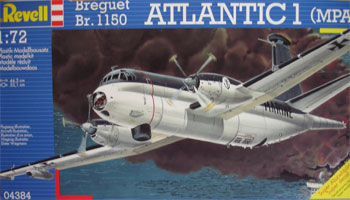
Dimensionally and looking how it looks, this Revell Germany kit is very good indeed. No main faults can be found at all, and build straight from the box, you get a very good Atlantic model. Still, some minor improvements can be done, as will be indicated on these webpages.
In 10 sprues you get about 230 parts in white plastic, a good cockpit glass canopy and nose. Some sink marks are present, needing minor filling. Not all parts are needed, but depend on the version.
The kit has finely engraved panel
lines but the fuselage is in separate sections of forward-mid- and aft
stations. Also a full bomb bay is provided and a choice of weaponry of
depth charges and torpedo's, a nice cockpit with instruments and seats.
You will need to add sufficient weight in the nose to prevent "tail sitting".
The "antenna" wires are better done with fine fishing line after overall
finishing and painting. The undercarriage is also very nicely done, but
needs careful assembly. A rear open entry hatch is also an option, but
you will need to add some bulkheads then inside to avoid an empty look
inside.
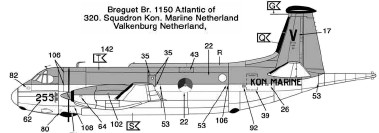
Decals for three versions are provided: a Dutch Navy Valkenburg plane, a French 24 Flotilles Aeronavale and German Navy MFG5 plane. The decals have also many airframe stencils and detail markings. Instructions are typical for Revell with no lesss than 78 steps !
NOTES ON THE DECALS:
- the blue in the Dutch roundels
are a bit too light blue.
- the french insignia "anchors" should
be black, not blue!
- some smaller stencilling can be
improved; this will be noted later on when applying the decals
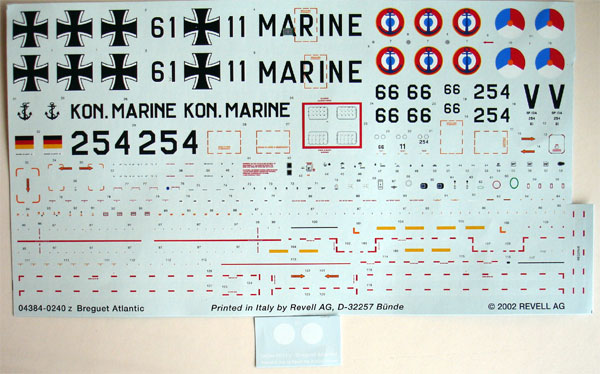
Colors of Revell are only indicated
in the instructions (see more later on at "painting").
A Dutch Royal Navy Flying Service
(MLD) Atlantic will be made out of this Revell kit, using many of the kit
decals.
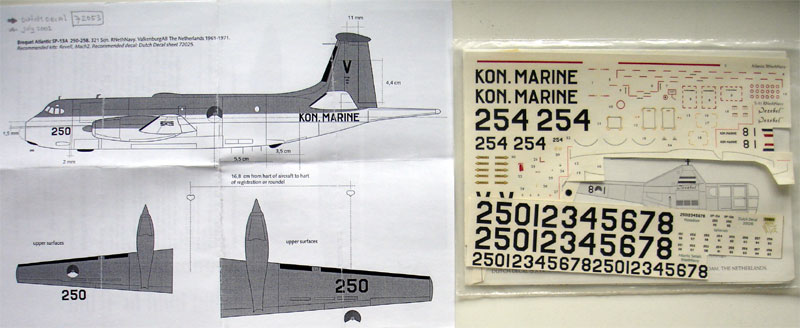
Dutch Decal
set 72025 will also be used in some areas to improve further the
good kit decals.
![]()
The Build
Assembly starts with the weapons
bay, the parts are very delicated.
The fuselage is made up by separate
sections, but I only needed minimal filler and sanding. The ice protection
plates on the fuselage sides are nice touches. The inner fuselage was painted
dark grey near the windows. I also drilled open the APU exhaust pipe aft
of the right cockpit.
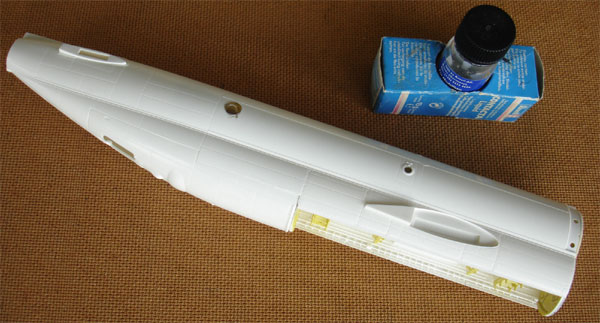
The cockpit area is well done with
many parts and good seats.
 .
.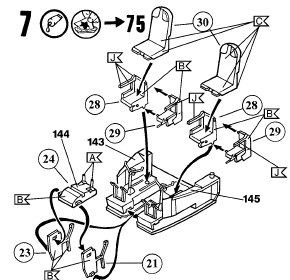
 .
.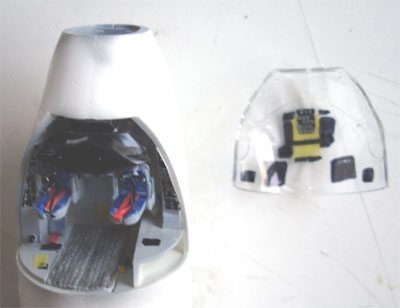

The floor was painted blue-grey, some
parts dark grey and black-grey and the seat cushions bright blue with red/orange
straps.
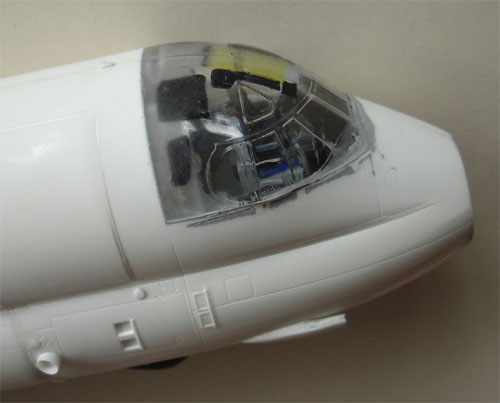
The glass part was fitted and some
filling with putty was needed. Add nose weight (70 grams !) and you will
trouble finding space for it.
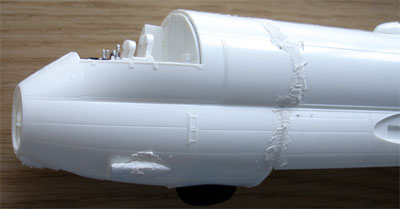
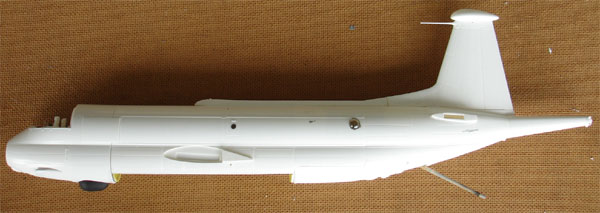
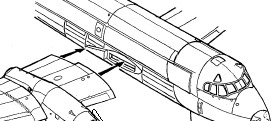
NOTE: The wings can be attached later on using the glueing lips and although I did not, I would recommend making a wing spar to get extra strength. Later on I found out that in fact it is better to make a spar.
The radar shown in step 14-15 is retractable, a nice touch. Do not fix in position until later to ease painting.
In step 21- 22: some ejector pin marks are on the innner tail plane halves, sand these off.
In step 26 it is suggested to drill
some holes, but this is not needed for the Dutch Atlantic.
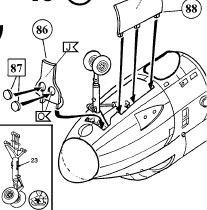
The undercarriages and their bays
are very good, even the tail pipes are shown at the ceilings. The bays
(including the weapons bay) were painted chromate yellow / beige "chamois",
with the pipes aluminium/black.
| ..chamois.. |
The gear was not fitted yet however, to be done later on.
In step 31-32 it was decided to open up an engine with open hatches, with a scratch engine. This to add some more interest to the model, using this picture of the real thing:
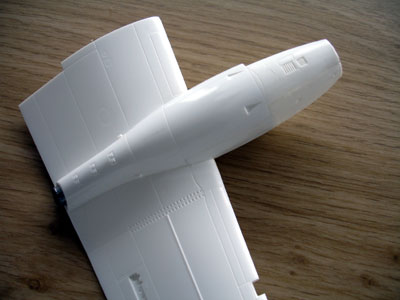 ..
..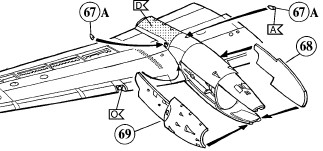
.

The engine was made from scratch
from bits and pieces from the spares box using the picture of the Rolls
Royce Tyne engine.
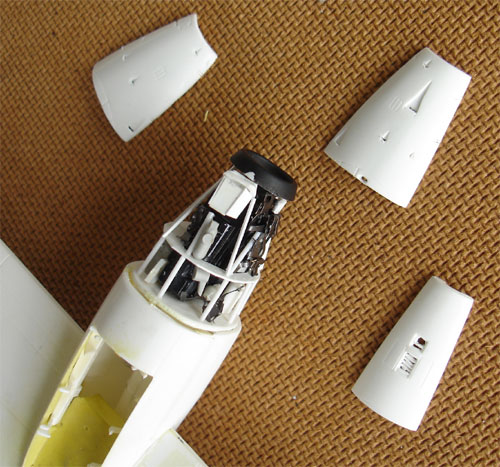 ...
...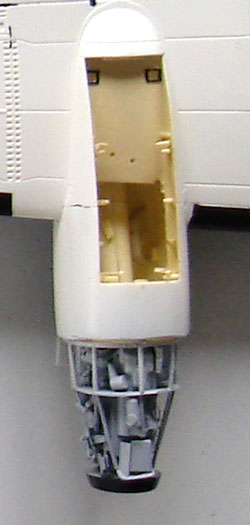
The engine area further detailled.
TIP: At step 33, it was decided NOT to fit the wings and stabilizers yet, as masking of particularly the black de-icing boots would be much easier when done with these parts still separate.
In step 57 you can select an open or closed weapons bay. When open, you need to cut out carefully a center section in each door.
Skip steps 64, 65 and 66 completely
for the Dutch Atlantic. Antenna parts #126 and 146 are needed for a Dutch
Atlantic.
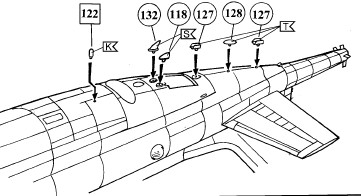
In step 72 and 73 use indeed the rounded wing tips for a Dutch Atlantic.
To next [ Page
2 .....]
References
IPMS Nederland real Atlantic pages
http://www.ipms.nl/mip/atlantic.html
(Dutch IPMS reviews)
Back to 1/72 models...

(c) Copyright Meindert "designer"/ All rights reserved. Your comments are welcomed by webmaster
January 2, 2008